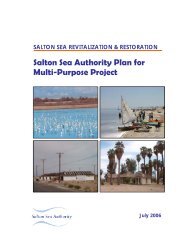Salton Sea Preliminary In-Sea Geotechnical Investigation
Salton Sea Preliminary In-Sea Geotechnical Investigation
Salton Sea Preliminary In-Sea Geotechnical Investigation
You also want an ePaper? Increase the reach of your titles
YUMPU automatically turns print PDFs into web optimized ePapers that Google loves.
SECTIONSIX<strong>Preliminary</strong> Embankment Design ConsiderationsSECTION 6PRELIMINARY EMBANKMENT DESIGNCONSIDERATIONSThis section provides preliminary considerations for the design of embankments that may be incorporatedinto the restoration project. It provides a preliminary evaluation of the requirements to obtain a stableembankment, alternatives that could be used to prepare the foundation of the embankment, potentialground improvement techniques for both embankment and foundation soils, an estimate of postconstruction settlement magnitudes and rates, and potential in-<strong>Sea</strong> borrow sources.6.1 EMBANKMENT STABILITYA critical element of the embankment design will be the stability of the embankment slopes both duringconstruction and during an earthquake. The current concepts generally incorporate embankment slopesthat are at inclinations of 2½:1 (horizontal:vertical) or flatter, with seafloor deposits that had beenoverexcavated to a depth of 25 feet and replaced with suitable materials. The slope inclinations wereselected based on engineering judgment; no specific slope stability analyses were performed. The depthof overexcavation was selected based only on the data that was available at the time, the 1974 Bureau ofReclamation investigation that was only in the southern end of the <strong>Sea</strong>, and on construction experience ofthe Great Salt Lake railroad causeway in the 1950s.The results of the preliminary geotechnical investigation indicate that the soft/weak soils may extenddeeper than 25 feet in the central and easterly portion of the mid-<strong>Sea</strong> alignment. Greater depths ofoverexcavation and replacement below planned embankments would greatly increase the cost of thoseembankments. Alternatively, the embankments could be constructed with flatter inclinations that wouldbe stable. The embankment construction may also need to be staged to allow pore pressures induced bythe embankment fills in the fine-grained foundation soils to dissipate, and allow the strengths to increasein the foundation soils.Static slope stability analyses have been performed using the undrained strength test results from thisinvestigation. These tests indicate that the c u /σ v ’ ratio for the seafloor and soft lacustrine deposits is about0.3 to 0.4. Limited parametric analyses were performed by varying the inclination of the embankmentslopes and the depths of foundation soil overexcavation. The results of these analyses are presented inTable 9. Graphical results of the stability analyses are contained in Appendix D. The results of theseanalyses indicate that an embankment with a crest elevation of -225 feet MSL and 2½:1 slopes wouldgenerally require 35 feet of overexcavation to be statically stable. These simplified analyses assumed apotential failure in the foundation soils and generally loose to medium dense granular embankmentmaterials (with a friction angle of 30 degrees); some sort of rock shell would need to be incorporated intothe design for 2½:1 embankment slopes to be stable. Embankments with 6:1 slopes would generally bestatically stable with about 10 feet of overexcavation, and embankments with 10:1 slopes could staticallybe stable if placed directly on the seafloor. Less overexcavation would be required for embankments withcrest elevations of -240 feet MSL, a case that was analyzed for a lower <strong>Sea</strong> level.The static analyses assume that neither the foundation or embankment soils lose strength during anearthquake. These soils could lose strength if they were to liquefy, or have strain-softening behavior thatcould be exhibited in sensitive clays. It is anticipated that the majority of the foundation soils will be fine-W:\27663042\00005-c-r.doc\1-Mar-04\SDG 6-1



